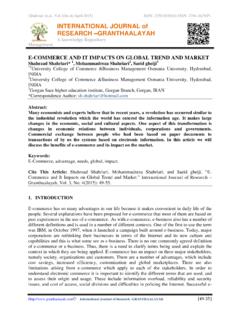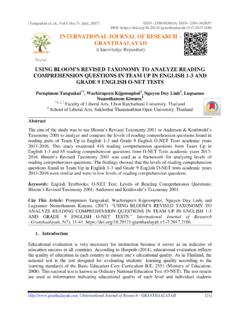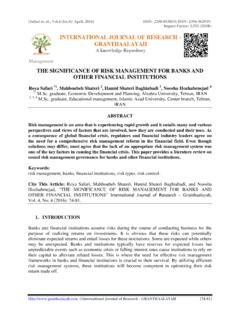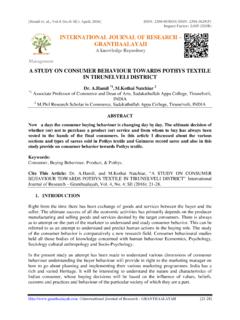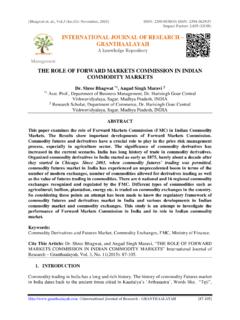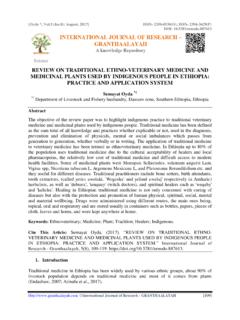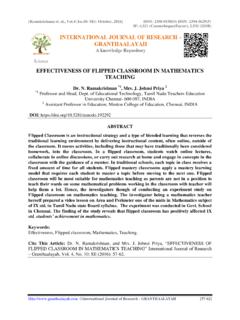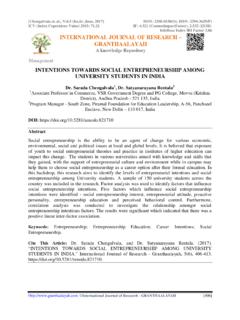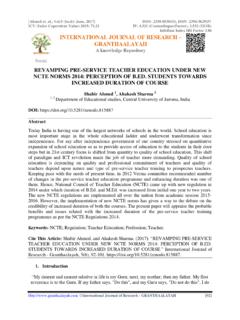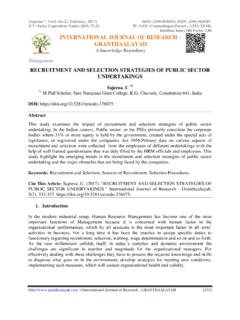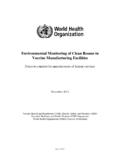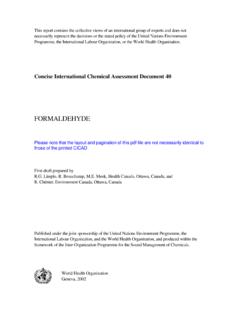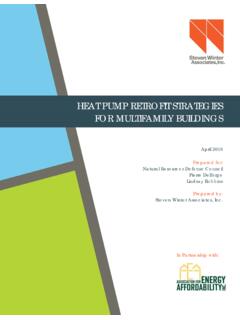Transcription of PAINT POLLUTION HARMFUL EFFECTS ON ENVIRONMENT
1 [Social Issues and Environmental Problems, ( :SE): Sep, 2015] ISSN- 2350-0530(O) ISSN- 2394-3629(P) Impact Factor: (I2OR)DOI: International Journal of Research - GRANTHAALAYAH [1-4] PAINT POLLUTION HARMFUL EFFECTS ON ENVIRONMENT Tina Porwal Girls College, Indore, ( )ABSTRACT Every year we like to PAINT our home, furniture, etc. for decoration, protection, identification, sanitation. But we forget the impact of PAINT on our ENVIRONMENT . This can cause some serious hazardous effect on our body like headaches, trigger allergies, asthmatic reactions, irritate skin, eyes, and put increased stress on vital organs such as the heart and not only PAINT but also its byproduct or by which PAINT creates are also more dangerous to us and our ENVIRONMENT .
2 Keywords: PAINT , ENVIRONMENT , POLLUTION , VOCs, Pigments. INTRODUCTION PAINT generally include pigment (the colour), carried by a resin and/or binder, a solvent to help the PAINT application, and a dryer. In vinyl and acrylic paints they will also include plastics compounds. Some will include formaldehyde, arsenic, thinners, and foamers. PAINT typically consists of pigment, resin, solvent and additives: Pigment-to provide colour, hiding and control gloss. Pigments are usually divided intotwo groups. One called Prime Pigments includes pigments such as Titanium Dioxide(white), Chrome Green Oxide, Yellow and Red Iron Oxides, etc.
3 The other group ofpigments is called Extender Pigments and includes Calcite (Calcium Carbonate), Talc(Magnesium Silicate), Mica, Barytes (Barium Sulphate), etc. Resin the binder to hold the pigment particles together and provide adhesion to thesurface painted. Waterborne paints most often use acrylic emulsion polymers as come in a wide variety of types and combinations. Common acrylic polymer typesare based on monomers such as methyl methacrylate and butyl methacrylate. Traditionally,lower cost paints have been formulated on PVA (Poly Vinyl Acetate) resins come in a very wide range of types.
4 The most common solvent basedresins are termed alkyd resins that are normally used in enamel paints. Urethane alkydsoften used in clear varnishes. Protective coating resins include types such as Epoxy,Urethane, Polysiloxane and Moisture Cured Urethane. Solvent to act as a carrier for the pigments and resin the solvent may be organic (suchas Mineral Turps) or water. Additives to enhance certain properties such as ease of brushing, mould resistance, scuffresistance, drying and sag resistance.[Social Issues and Environmental Problems, ( :SE): Sep, 2015] ISSN- 2350-0530(O) ISSN- 2394-3629(P) Impact Factor: (I2OR) International Journal of Research - GRANTHAALAYAH [1-4] PAINT is more than just the colour though; it is a material that is applied as a liquid and dries by a variety of chemical processes to a solid.
5 We apply PAINT for: Decoration Protection Identification Sanitation HARMFUL EFFECTS OF PAINT POLLUTION Prolonged or high exposure to PAINT and PAINT fumes can cause headaches, trigger allergies and asthmatic reactions, irritate skin, eyes and airways, and put increased stress on vital organs such as the heart. The world health Organization (WHO) has reported a 20%-40% increased risk of certain types of cancer (in particular lung cancer) for those who come into regular contact with, or work with PAINT while Danish researchers point to the added possibility of neurological damage.
6 By far, the most important environmental impact from paints is the release of volatile organic compounds (VOCs) during the drying process after the coating is applied. Virtually everything but the solids in a typical PAINT formulation is released to the air. Once in the atmosphere, VOCs participate in the formation of ozone. In the presence of nitrogen oxides (NOx) and sunlight, VOCs react with oxygen in the air to produce ozone, the most toxic component of the form of POLLUTION commonly known as smog. Ozone attacks lung tissue, and is very injurious, even in very low concentrations.
7 To prevent the formation excessive levels of ozone, the VOC content of PAINT , and its conditions. Lead in house PAINT is a problem only if it is damaged or disturbed. PAINT in good condition that is not flaking or chalking, or is covered by well-maintained lead free PAINT is not a hazard in itself. Lead can also be a hazard when it is on surfaces subject to friction or impact such as windows and doors, or on railings where children can chew it. High concentrations of lead found in garden soils in older residential areas can be due to residue from lead-based PAINT . Lead-based PAINT is most likely to be found on window frames, doors, skirting boards, kitchen and bathroom cupboards, exterior walls, gutters, metal surfaces and fascias.
8 It can also be found on interior walls, ceilings and areas with enamel PAINT . Pink and red primer both contain lead, so you should think twice before disturbing any surface which has had any of these paints applied. The main environmental impacts associated with PAINT come from the manufacturer of the components, rather than manufacturing of the product itself. Titanium Dioxide By far the greatest environmental impact is derived from the manufacture of Titanium Dioxide (TiO2): High embodied energy (54 - 76 MJ/kg) 9. Emissions during manufacture including (depending on process) CO2, N2O, SO2, NOx CH4 and VOCs 9.
9 A number of waste streams, including spent acid and metal sulfates, emanate from the manufacturing process, each of which carries an environmental impact. A number of EU directives seek to reduce and eliminate the POLLUTION caused. Raw materials are derived from scarce resources. [Social Issues and Environmental Problems, ( :SE): Sep, 2015] ISSN- 2350-0530(O) ISSN- 2394-3629(P) Impact Factor: (I2OR) International Journal of Research - GRANTHAALAYAH [1-4] Coloured pigments The environmental impacts associated with coloured pigments are various - though not as intense in their EFFECTS as those for Titanium Dioxide.
10 It is worth noting too, that although there are 'natural' and 'man-made' pigments, not all 'natural' pigments have a lesser impact than man-made. Specifiers are recommended to examine closely the claims made by the manufacturer. VOCs and Ozone Ozone produced as part of human activities is a pollutant and a constituent of smog. Ozone is formed when nitrogen oxides, carbon monoxide and VOCs react in the atmosphere in the presence of sunlight. Although lead has been banned for use in PAINT for decades, other chemicals commonly found in PAINT have also been linked with significant health and environmental issues.
